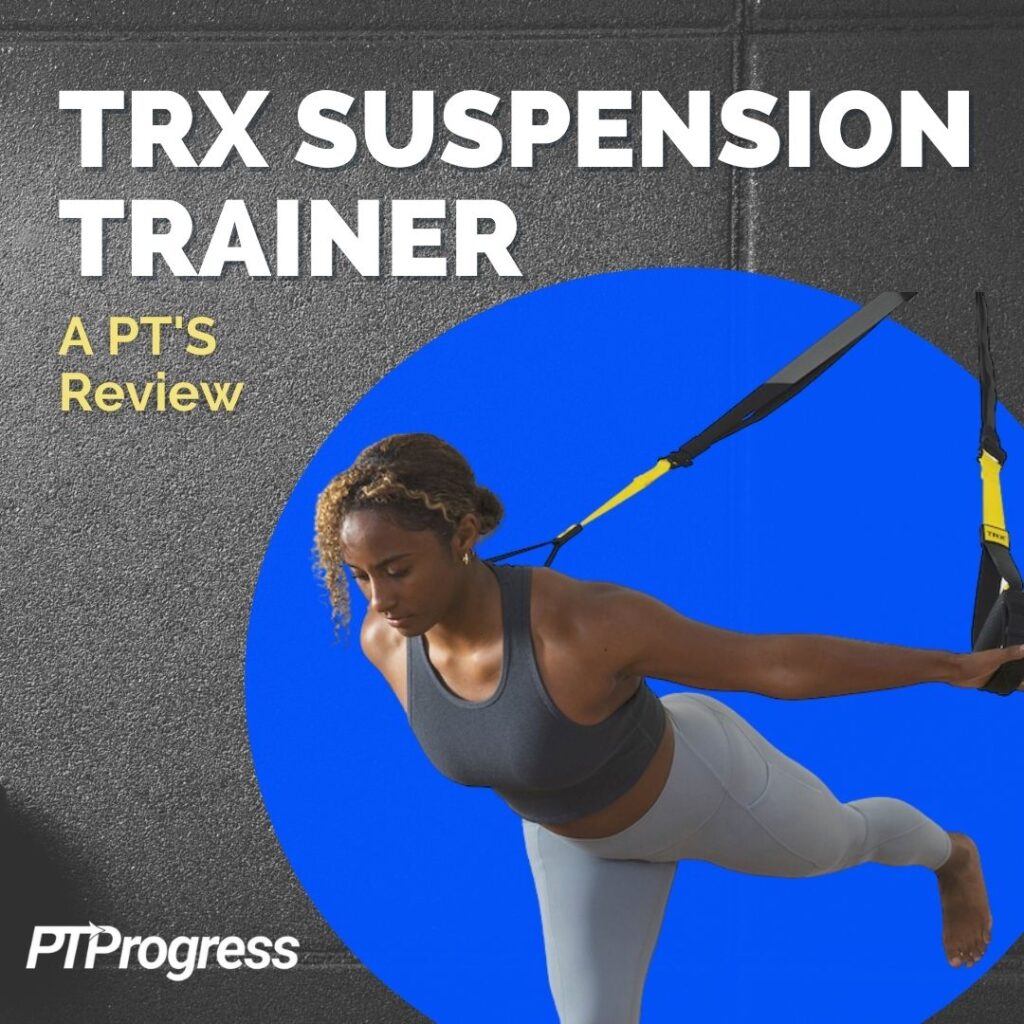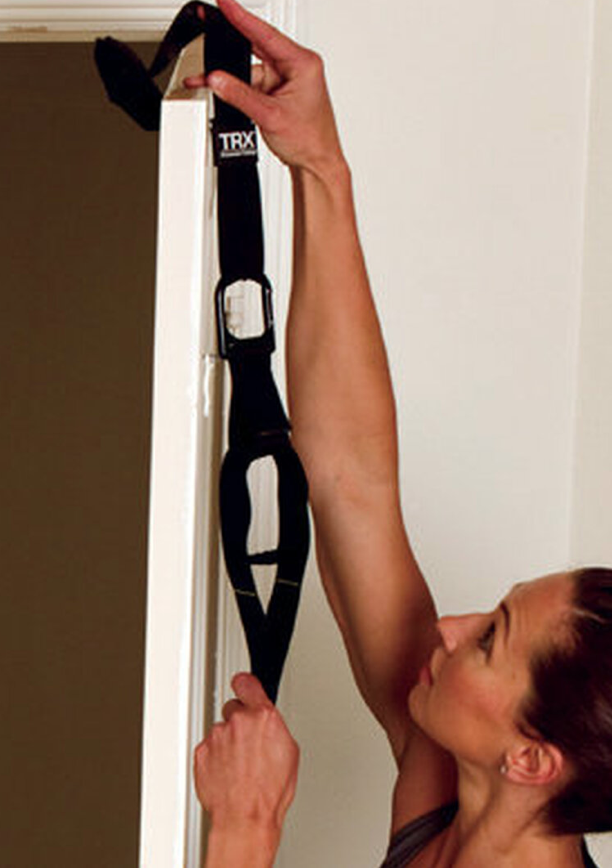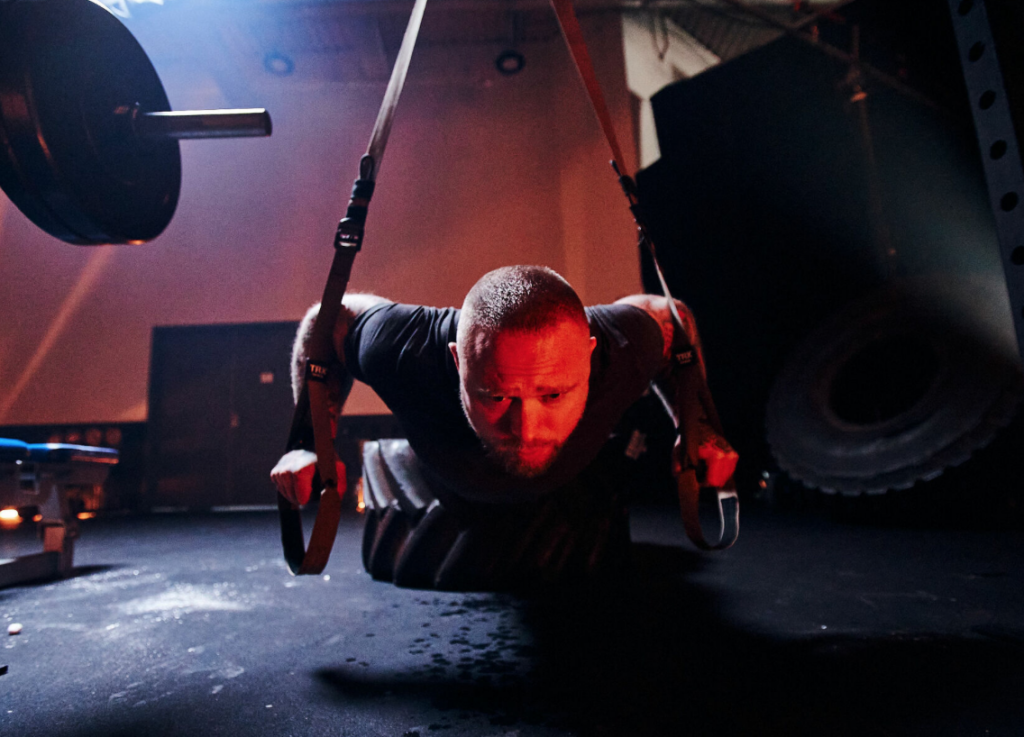With the TRX Suspension System, you could convert any room in your house into an entire gym, all for less than $200. Sound too good to be true? Then keep reading for my full review and find out why I think TRX Suspension Trainers should be standard in every home gym.
* Save 15% on All TRX products with the promo code: PTPROG15TRX
Living the Home Gym Life
If you’re trying to get in shape, build muscle, lose fat, or even recover from an injury, you’ve probably considered some form of at-home exercise. Beyond a yoga mat and hand weights, at-home exercise equipment can get really expensive really quickly. (I’m thinking of a bike that starts with the letter P…)
Many times, these expensive machines target only one area of the body or give you only one form of exercise. Over time, you may end up accumulating several of these “one-hit wonders,” spending both money and floor space—all for the sake of fitness.
But in my experience, you don’t have to shell out thousands of dollars to build a home gym. In fact, for less than $200, the TRX Suspension System can help you work out your upper body, lower body, and core. As one of the most versatile pieces of equipment you can have in your home gym setup, it can challenge anyone at any level.
So, what is TRX?
TRX stands for Total Body Resistance Exercise. Instead of dumbbells or bands, in TRX it’s your bodyweight that provides the resistance for each exercise.
The TRX Suspension System is a simple setup of 1) straps and anchors, which are secured into a doorframe or around a weight-bearing beam, and 2) loops and handles, which you’ll use to achieve suspension resistance.
If that sounds complicated, let me demonstrate for you:
Yes, I have a TRX suspension trainer. TRX did not pay me to do this review, but they did send out a few extra pieces of equipment so I could demonstrate their new Pro4 system.
There are actually seven different types of TRX trainers available, but most people choose the Home2, Tactical, or Pro4 models. I’ll review the differences between each model later on.
How to Set Up the TRX Suspension System
Regardless of the model you choose, setup is a snap, and TRX provides a couple ways to secure the straps. The first is by using an “over the door” anchor, which wedges through the crack at the top of a closed door.
If somehow a door isn’t available or you’d prefer an alternative setup, you can anchor the XMount (sold separately) to the ceiling or a wall. This may require a little more space but could provide even more stability and versatility to your home gym.
But the TRX system isn’t confined to the indoors. You can take your home gym outside by wrapping the TRX suspension anchor around a solid pole, handrails, or even a sturdy tree. Just be sure to always attach the main carabiner to the bottom loop of the suspension strap. Once the straps are locked in, you’re ready to use it.
Aside from this minimal setup, the TRX system is essentially ready to use right out of the box. It breaks down as easily as it sets up, and all the equipment fits into one mesh bag, making it convenient to bring wherever you go.
How to Use a TRX Suspension Trainer
There are hundreds of ways to use the suspension trainer. Something this versatile is bound to support a wide variety of movements.
But the most intuitive way—and the way I demonstrated above—is to hold both handles with your arms extended while facing your anchor. From here, using arm strength alone, try pulling yourself up until your chest meets your hands.
If you’re not feeling challenged by this movement, simply walk your feet closer to the door. Because the strap length stays constant, scooting your feet in will incline the angle and increase the resistance in your movement. The reverse is true as well; if this movement is too challenging, inch your feet away from the anchor and reduce the angle.
In bodyweight training, you are the resistance, so you completely control how easy or challenging your workout is. Best of all, you don’t need a $1,000 row machine to replicate this simple pulling motion. Nor do you need a $500 bench press to mimic the chest press movement you’d achieve by facing away from the door, like so:
The TRX trainer is not just an upper body workout system. It bears repeating that this suspension system can work your entire body: arms, shoulders, abs, glutes, calves—you name it. Those handles that you use to pull yourself toward your anchor can also support your feet, allowing you to improve your core stability and strengthen your legs.
But you don’t have to figure it out on your own. In fact, when you buy the system, you’ll receive one year’s access to thousands of workouts and videos on the TRX Training website.
Which TRX Straps are Best for Home Use?
If you’re wondering which system to buy, keep in mind that the TRX suspension models are all very similar. All come with the following features:
- two handles
- adjustable foot cradles
- a door anchor and suspension anchor
- a storage bag
- free shipping
- access to the TRX app
The differences between the models lie in subtle details which may or may not matter to you.
Comparing the TRX straps
For example, the handles on the Home2 model are made of dense foam, whereas the handles on the more expensive Pro4 and Tactical models are textured rubber. A textured rubber handle is easier to wipe clean and sanitize, so you might prefer this detail if you share your TRX trainer with a wider community. But in general, I find the dense foam handles of the Home2 more comfortable to grip.
Another perk to the Pro4 and Tactical models is the included Xtender strap; you’ll need one to bring the handles closer to you if you mount your TRX suspension system to the ceiling.
Besides harder handles and an included Xtender, the biggest difference between the Pro4 and Home2 systems is that the Pro4 comes with a “theft-resistant” lock on the carabiner. With a simple allen wrench, you can tighten this lock in place and prevent anyone from swiping your straps. The Home2 model doesn’t include this feature, primarily because if you’re just going to use this at home, instead of in the clinic or a gym, you really shouldn’t need anti-theft security.
Originally designed for military use, the Tactical model sets itself apart with features of durability, wear-resistance, and fit. The foot cradles are oversized to accommodate combat boots, and the straps are UV-resistant, adjustable with a D-ring lock instead of a barrel lock. If you want a digital version of the US Military’s 12-week conditioning program, then you’ll enjoy the elite TRX Force app, yours when you purchase the Tactical suspension system.
Finally, the Home2 model has a 6-year warranty while the Pro4 and Tactical promise a 10-year warranty.
When it comes down to it, the TRX Home2 system is perfect for your home gym, and it costs $50 less than the other two models. But if you don’t like the padded grip or prefer to have a larger foot loop, you should consider the Pro4 or Tactical model.
Comparison of TRX systems:
| Home2 | Pro4 | Tactical | |
| Price | $199* | $249* | $249* |
| Handles | Dense foam | Textured rubber | Textured rubber |
| Anchors | Door and suspension | Door, suspension, and extender | Door, suspension, and extender |
| Anti-theft lock | No | Yes | No |
| UV-resistant | No | No | Yes |
| Warranty | 6 years | 10 years | 10 years |
| App access | TRX App | TRX App | TRX App and TRX Force App |
TRX Suspension Trainer: Is It Worth It?
As a PT, the biggest question I hear from my patients concerning the TRX system is whether it’s worth the money, or if a knock-off version is just as good. The Home2 system is priced at $199 (or $169 with the coupon code PTPROG15TRX), but you could snag a knock-off version for around $100 or $150.
To be honest, I’ve used knock-offs once or twice and didn’t have any problems with them—they didn’t break on me then and there. However, knock-offs lack some of TRX’s patented safety features, such as the anti-slip loop which keeps the straps from slipping out and causing an injury.
So is saving $50 worth sustaining an injury? Not to me it isn’t. I’d pay much more than $50 to avoid injuring myself on a cheaper piece of knock-off equipment. I also can’t speak to how long a knock-off will last, whereas the TRX trainers are built to endure several years of hard use.
Knock-off trainers populate the pages of Amazon and other retailers, but you can be confident you’ll get the real deal by purchasing through the TRX training website.
So there you have it, my take on the TRX suspension systems. Below I list some pros and cons of TRX before diving into three common myths you may have heard about suspension trainers.
Pros and Cons of the TRX Suspension System
Pros:
- Travel-friendly
- Compact
- Affordable
- No weights needed
- Progressively resistant
Cons:
- Requires daily setup (unless you permanently anchor it)
- Limited to bodyweight
- Not cheap—although you can get 15% off your order with the code PTPROG15TRX
Myths about Using a TRX Suspension System
For a young athlete, the benefits of a TRX system are easily evident, but not everyone finds suspension training appealing. In fact, people over the age of 55 are sometimes the most reluctant toward suspension training, citing these three common myths.
Myth #1: “You Have to Be in Shape to Use TRX”
If you only look at Internet and TV ads, sure, you’ll think TRX is only suitable for young, sleek, and chiseled athletes. But don’t be intimidated by this incomplete representation. Most anyone could use and benefit from TRX: whether you’re a professional athlete, an older adult who wants to be more active, or someone who has difficulty getting up from a chair.
The reason why TRX is so universally effective is because it uses your bodyweight for resistance. You can easily modify any activity or workout with the TRX straps; simply move towards or away from the wall, door, or anchor point to make an exercise harder or easier. Generally, the more suspended the angle, the more bodyweight you’ll resist.
Plus, the TRX straps can help you focus on maintaining correct form as you exercise, which is one of the most important things we physical therapists emphasize to our patients.
I would actually argue that older adults will benefit even more from the low-impact exercises of TRX than they would from the traditional weightlifting or cardio workouts of a treadmill or stairmaster.
So if you’re looking to incorporate home exercise and you’re over the age of 55, you’re the perfect candidate for TRX.
Myth #2: “TRX Straps Are Too Complicated to Use/Set up”
Just because this system is new to you doesn’t mean it will be difficult to learn. In fact, most people find the straps very easy to use and set up.
I’ll guide you through some setup details below, but you can also watch demonstrations of TRX setup on YouTube.
Every model comes with a couple options for anchoring the straps.
1. Over a door
First, open the door. Attach the suspension carabiner through the loop at the bottom of your door anchor. Then, hang the anchor (the “pillow”) over the top of your door, slide it over, and close the door. Once you attach the straps to the carabiner, you can begin your workout.
When using the over-the-door anchor, I recommend sliding it towards the hinges of the door, where it’s sturdiest. It’s also smart to set up so that you are essentially “pulling the door closed,” against the direction it normally opens. It can work the other way too, but just make sure the door anchor is close to the door hinges and the door is locked, so no one accidentally opens it on you.
2. Over a beam
Find a sturdy, weight-bearing beam. Take the suspension strap and loop it around the beam a few times, as if you’re bandaging a finger. Once you have a good “tail” left to the strap, thread the end through the suspension carabiner. You’ll then attach the main carabiner (what your straps are connected to) to the bottom loop of the wrapped suspension strap.
You can also use the XMount to anchor the straps to the ceiling or a wall. The ideal height of the main carabiner should be 6 feet from ground level, which is about where you’ll have it with the door frame setup. But if you anchor it to the ceiling, you’ll likely need the Xtender strap to bring your main carabiner to that 6-foot height.
Once the suspension trainer is anchored, you can adjust the length of the straps for best fit. Simply press your thumb against the locking anchor and pull down to lengthen the straps, or pull up on the yellow tab to shorten them.
Myth #3: “TRX Won’t Help Me”
Maybe you’re thinking, “Well, I’m not looking to strength-train or build muscle, so the TRX straps aren’t for me.”
I beg to differ. Sure, walking is great, and cardio exercises are indispensable. But as we age, strength-training becomes more important than ever to preserve muscle mass and prevent injury.
In addition to strength-training, the TRX straps facilitate a wide array of exercise routines. In fact, you can use them to improve your balance, work on stability, stretch, do yoga, or even try cardio. Such workouts are among the hundreds you can find on the TRX workout app or for free on YouTube.
As long as I’ve been at my physical therapy clinic, we’ve had a TRX system, and we use it all the time to help patients rehabilitate and gain strength. You can also find a whole community of athletes and celebrities who rely solely on the TRX suspension system for maintaining their physique.
Dollar for dollar, I think the TRX is absolutely one of the best pieces of equipment you can add to your home gym, especially if you’re over age 55. TRX enables you to build strength through low-impact exercises in a format that is consistent and customizable to your level of fitness, wherever you are.
I promise, as a physical therapist, you won’t find any other home workout system that’s nearly as versatile and affordable as TRX. And with the coupon code PTPROG15TRX, you can get 15% off your entire TRX order.
TRX Suspension FAQ
What does TRX stand for?
TRX stands for Total Body Resistance Exercise.
How Often Should You Do TRX?
You can perform TRX 5-6 times a week, but it’s best to vary what you’re doing. Aim for a steady rotation of cardio and strength exercises for different muscle groups. With TRX, it’s easy to achieve such comprehensive variety because with this one system you can work on a lot of different muscle groups.
Will TRX Damage My Door Frame?
No; just make sure you set it up properly. Slide the strap so it’s near the hinges, and position yourself so that the door is being pulled inward, towards the frame, and not outward.
Other TRX Products: Resistance Bands and the Bandit
If you love the versatility and benefits of the TRX suspension system but don’t love its price tag, don’t worry. There are more affordable ways to strength-train at home without settling for a knock-off suspension trainer.
Resistance bands are a favorite among therapists and a frequent feature of this blog for many reasons. With resistance bands you can:
- Rehabilitate an injury
- Improve range of motion
- Strengthen muscles and build mass
Plus, resistance bands are fully scalable, just like TRX—you can easily modify each exercise by shortening or lengthening your hold on the band. The main difference is that, with bands, the resistance comes from the band’s elasticity, not your bodyweight.
Resistance bands typically come in sets of varying thicknesses and corresponding colors. I recommend getting an over-the-door anchor for even more versatility in exercise movements.
TRX Exercise Resistance Bands
The high quality and durability of the TRX suspension system reflects in their resistance bands, of which there are a few varieties: Strength, Exercise, and Glutes.
Available in six thicknesses, the TRX Strength bands can provide up to 150 pounds of resistance. That means you could reap the benefits of heavy-lifting without storing and lugging around huge dumbbells.
But if you’re more interested in rehabilitating an injury or lightly toning your muscles, check out their four Exercise bands. They’re cheaper and more pliable than the Strength bands, but just as durable and beneficial.
Finally, the TRX Glute bands are short loops of tough elastic that you can wear around your legs and hips for a scorching glutes workout. They come in a pack of 3 levels of resistance, so as you get stronger you can continue to challenge yourself.
All resistance bands range from $11-41 each, depending on the resistance and style. TRX sells their bands in bundles, both with and without the suspension system.
But if you want an even more ergonomic resistance band experience, you need to check out the TRX Bandit.
TRX Training Gear: The Bandit
I’ve been using resistance bands for years, at home and in the clinic. The #1 complaint I hear from people is that “resistance bands hurt my hands.”
I agree—latex resistance bands can sometimes bunch up and pull on my fingers. This is uncomfortable for anyone, but it’s especially so for those with hand injuries or arthritis.
Some resistance bands feature carabiners and interchangeable handles, but I prefer using flat resistance bands because they’re really versatile.
Well, with TRX’s new Bandit accessory, you can have the best of both worlds: the versatility of flat bands with the comfort of an ergonomic grip. It’s such a genius invention, I wish I had thought of it.
Oh, and keep in mind: Although they did send me Bandits for free, TRX did not pay me for this review, either. My impressions reflect my true opinion as a veritable resistance bands expert.
Using a TRX Bandit
To use the Bandit, simply insert any flat resistance band into the slot, and boom—your band now has a handle.
The Bandit can improve many different movements, but I found them most helpful in mimicking almost any exercise I would do with a standard dumbbell. Whether that’s a biceps curl, a triceps extension, shoulder raises, or even a chest press, Bandits make flat bands so much more comfortable to use.
A pack of two Bandits costs about $29, which may seem a bit steep for just a handle. But when you have a latex sensitivity or a weak grip, this handle can make all the difference—especially if you’re just starting a routine of low-impact band exercises.
And you don’t have to use TRX bands exclusively to enjoy the Bandit. Most any other brand of flat bands could benefit from the Bandit. It’s a tool I’ve never seen before, and I think it’s a brilliant solution for people who find resistance bands uncomfortable.
If you’re just getting started with resistance bands workouts, check out their bands bundle: two bandit handles, two lightweight bands, and two heavyweight bands for $50. (Remember, my 15% discount applies to your entire TRX order, this bundle included! Just use the code PTPROG15TRX .)
Conclusion: TRX Suspension System = Your New Home Gym
In summary, TRX offers all you need to build a comprehensive, convenient, and affordable home gym. Whether you stick with their bands or take the plunge on a suspension trainer, you can’t go wrong with total-body, progressive exercise.
Be sure to visit the TRX training website for more details on their suspension systems as well as training videos to follow when you’re ready to workout. And for more information on resistance bands workouts, including physical therapy treatments, check out the blog!








